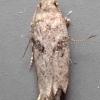35.136 Caryocolum blandulella (Tutt, 1887)
Status and Distribution
Rare and very restricted in its distribution having been found at five coastal sites, four in England and one in Wales. These are in Hampshire (last in 1891), Kent (last in 1983), Carmarthenshire (last in 2006), Suffolk (a single very worn specimen was new to the county in 2019) and Norfolk in 2020. Reports in 1979 and 1980 from Glamorganshire (the opposite side of the bay from the Carmarthenshire site and in the same 10km square) are unconfirmed, with searches for information and specimens failing to produce any positive evidence. The habitat is believed to be similar at both sites and searches for larvae and/or adults would be of value.

Provisional map
Foodplant and Larval Feeding Signs
Cerastium semidecandrum (little mouse-ear), see plant distribution map. In Europe has also been recorded on Cerastium pumilum (dwarf mouse-ear).
Spins the seed-capsules together.
Habitat
Sand-dunes.
Finding the Moth
Larva: feeds within seed-capsules which are spun together.
Adult: flies at dusk and during the night; is attracted to light.
Similar Species
One of our smaller Caryocolum species (wingspan 8.5-11mm).
C. blandella is usually larger (wingspan 9.5-14.5mm) and has a distinct row of black terminal dots on the forewing, absent in C. blandulella.
C. blandelloides, which is a northern Scottish sand-dune species, is slightly larger and has a less distinct black costal block.
C. proxima, which has a generally darker forewing (although paler or worn specimens can be problematic). Differences in the male genitalia are obvious but female genitalia differences are fairly minimal and require careful examination and comparrison.
A darker form occurs in Europe which could be confused with C. alsinella, but this has not been reported in Britain.
Single brooded, with very few dates available to assess full flight period which appears to be from mid-July to mid/late August.

